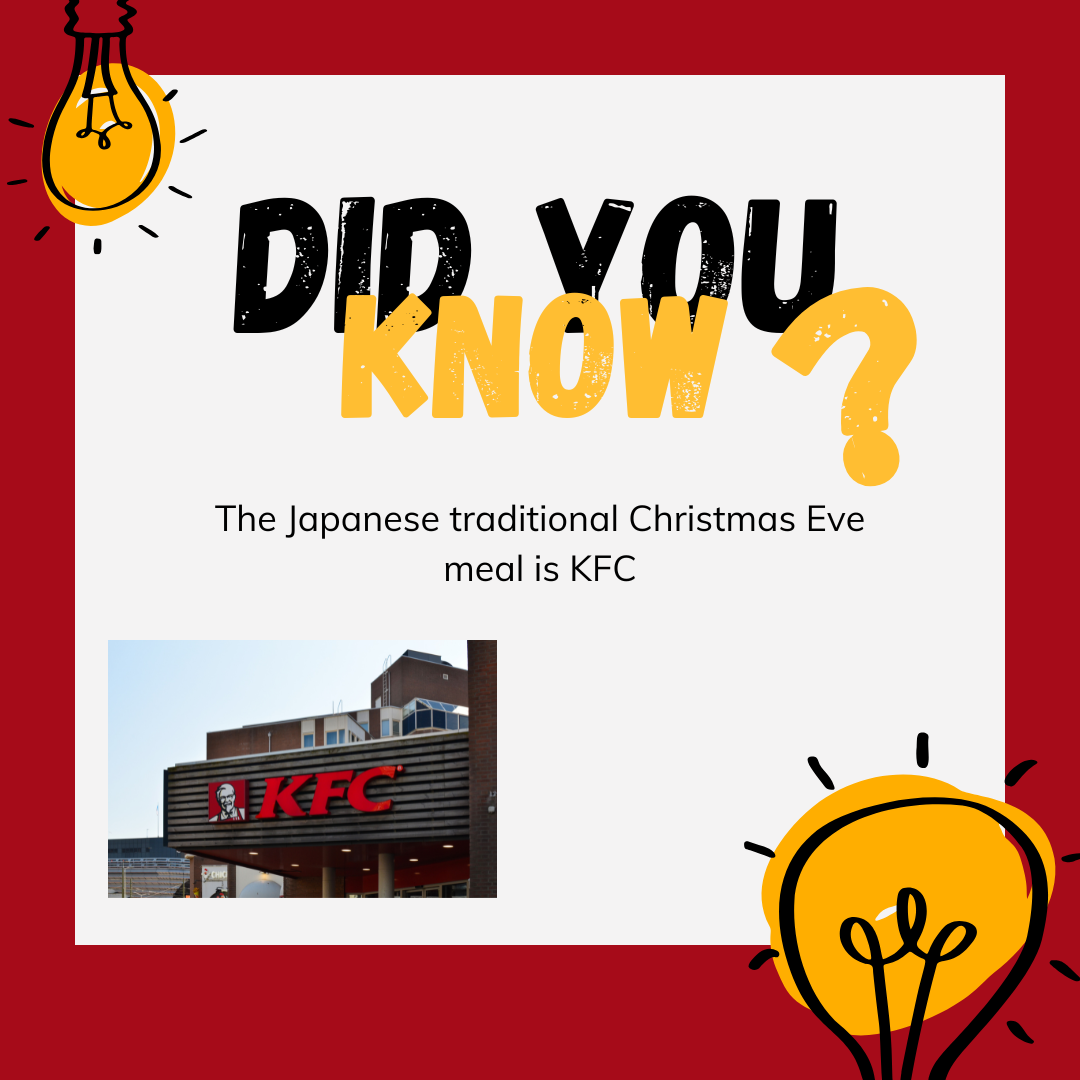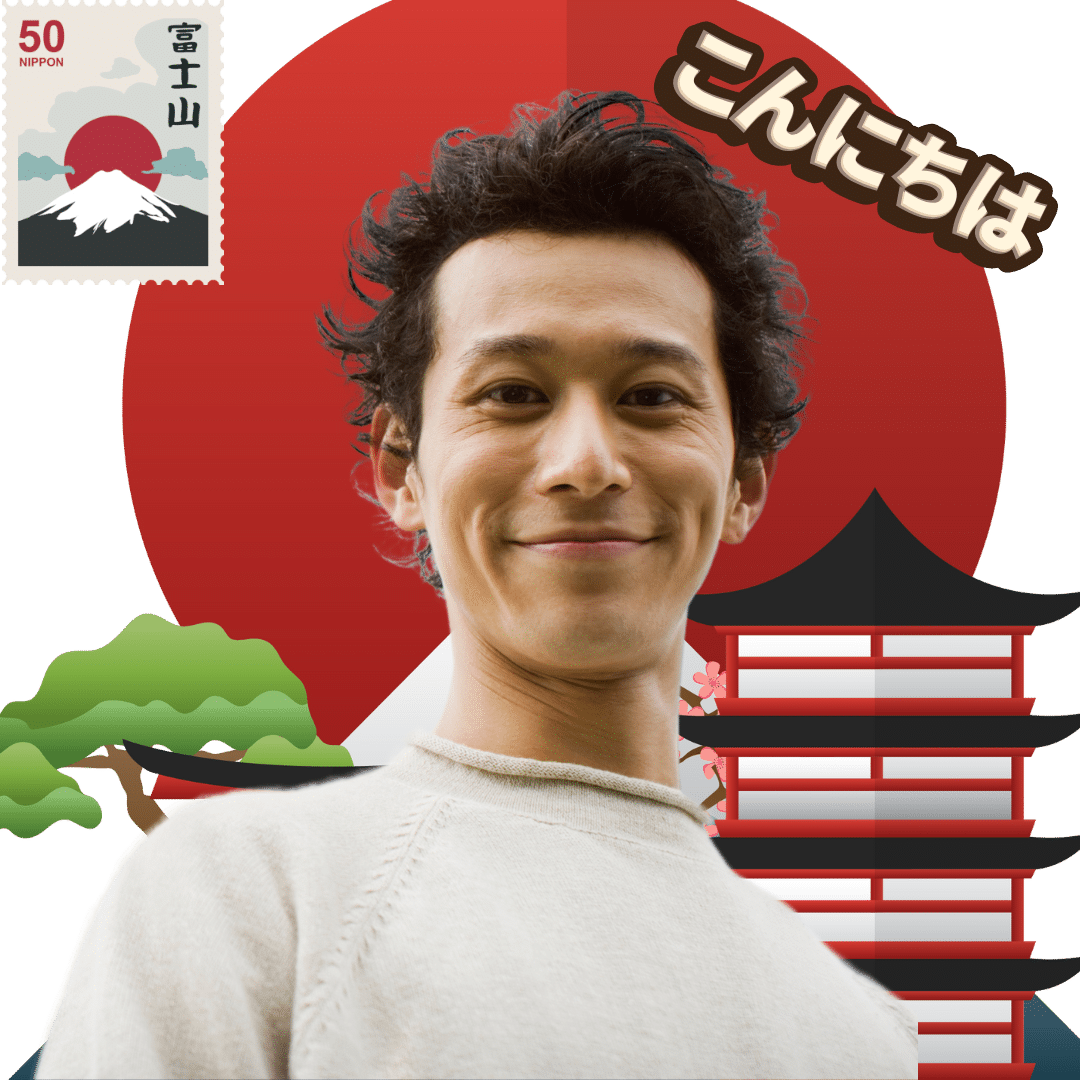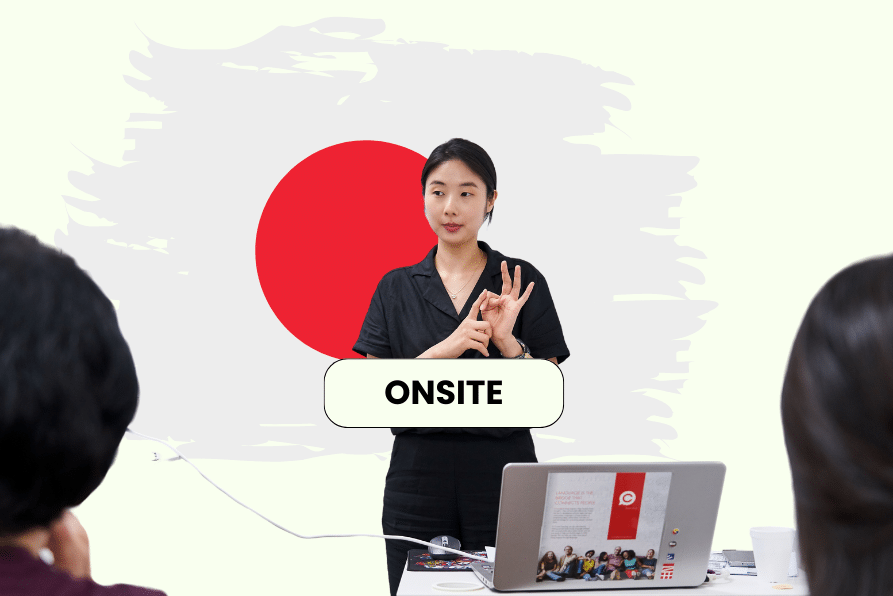Japanese Language Class
At Lingo & Taiyo, we view language primarily as a tool for communication. Learning a new language not only expands your mind but also allows you to connect with new people who offer different perspectives.
You don’t need to be fluent in Japanese to experience the benefits. Simply trying to speak a few words in Japanese will prompt your conversation partners to make greater efforts to ensure they are understood in English.
Our lessons are designed for those who wish to delve deeply into the language. At Lingo & Taiyo, you will explore the Japanese alphabet and grammar in depth. However, if you’re looking for a lighter approach, another language school may be more suitable for you. We promise to help you progress from having no knowledge of Japanese to being literate in just a few weeks.
Of course, conversation plays an important role in our lessons, too. That’s why we offer small group classes that encourage interaction. Speaking is a valuable skill, and we will focus on it as it will help you communicate more fluently and quickly.

Lingo & Taiyo is an official test centre
As an official test centre for MCYS and MFA officers, we take pride in ensuring the quality of our courses and assessments. With this expertise, we can deliver a comprehensive program that enables individuals to master the Japanese language.
Small group classes
We limit group sizes to a maximum of 8 participants to ensure the quality of our Japanese classes. When classes are small enough to facilitate individual student-teacher interaction, a minor miracle occurs: teachers teach, and students learn.
Centralised location
Our Japanese language classes are conducted at United House, which is centrally located and accessible. It is just a 6-minute walk from Dhoby Ghaut or Somerset MRT station.
Which course is for you?
Beginners, please choose Basic 1
New students with some Japanese knowledge: Please get in touch with us via the “Course placement” form
| Course Name | Start Date | Day | Time | Duration | Fee | Enrol |
|---|---|---|---|---|---|---|
| Japanese Beginner 1 By Ms. Ayaka (Online) | 07 Jan 2026 | Wednesday | 7:00 pm - 8:30 pm | 10 Weeks | S$348.80 | Enrol |
| Japanese Beginner 1 By Ms. Ayaka (Online) | 08 Jan 2026 | Thursday | 7:00 pm - 8:30 pm | 10 Weeks | S$348.80 | Enrol |
| Japanese Beginner 1 By Ms. Miyano (Onsite) | 15 Jan 2026 | Thursday | 6:30 pm - 8:00 pm | 10 Weeks | S$392.40 | Enrol |
| Japanese Beginner 2 By Ms. Miyano (Onsite) | 27 Jan 2026 | Tuesday | 7:00 pm - 8:30 pm | 10 Weeks | S$392.40 | Enrol |
| Japanese Beginner 1 By Ms. Maiko (Onsite) | 03 Feb 2026 | Tuesday | 7:00 pm - 8:30 pm | 10 weeks | S$392.40 | Enrol |
We also offer bespoke 1 to 1 and small-group private lessons for adults, delivered in person with flexible options at our Orchard centre or online. Click here to register your interest for 1 to 1 private classes.
There is a Japanese class for you
We believe learning any language starts with basic conversation. When you’re comfortable asking basic questions and talking about often-discussed topics, such as introducing yourself, lessons become more enjoyable, and you build momentum.
Onsite Japanese Class
Join our Japanese class at our convenient onsite location, just 6 minutes from Dhoby Ghaut and Somerset MRT stations. You’ll experience minimal hassle and travel time to reach
Group class starts at $392.40 for 18 hours. (Inclusive of textbook and GST)
1:1 private class

Private classes start at S$87.20 per hour, with a minimum commitment of 18 hours.
Click the button below to indicate your study preferences in the form, and we will contact you with a suitable starting date.
JLPT Test preparation

Get ready for the JLPT exams with our intensive 20-hour courses offered in the two weeks leading up to the exam.
You can practice both the written and oral components through mock exams. Our specialised teachers will cover all aspects of the exam to ensure you’re fully prepared
Further your Japanese language studies in Japan
Achieving N2 proficiency in Singapore can be challenging due to the limited opportunities for Japanese speaking practice. To help you overcome this obstacle and advance your language skills, we have partnered with Kansai College in Japan. Prepare in Singapore for your immersion in Japan.
Five progressive levels

A1 Beginner
- Understand and use familiar everyday expressions and very basic phrases.
- Learn Hiragana and Katakana
Basic 1: $392.4
Basic 2: $392.4
Total Fees: S$784.80
30 hours to complete

A2 Elementary
- Focus on the fundamentals of the Japanese language and seek to develop a well-rounded development in the aspects of reading, writing, listening and speaking in its native form.
- Completion of this level equips you to attempt JLPT-N5
Elementary 1: $425.1
Elementary 2: $425.1
Elementary 3: $425.1
Elementary 4: $425.1
Elementary 5: $425.1
Elementary 6: $425.1
Total Fees: S$2,550.6
90 hours to complete

B1 Pre-Intermediate
- In the Pre-Intermediate level, we will reinforce the grammar forms you learned previously and introduce new content through practical conversations, role-plays, and topical discussions.
- Completion of this level equips you to attempt JLPT-N4
Pre-Intermediate 2: $457.8
Pre-Intermediate 3: $457.8
Pre-Intermediate 4: $457.8
Pre-Intermediate 5: $457.8
Pre-Intermediate 6: $457.8
Pre-Intermediate 7: $457.8
Pre-Intermediate 8: $457.8
Total Fees: S$3,662.40
120 hours to complete

B2 Intermediate
- Building on the knowledge you gained in the Pre-Intermediate level, we will reinforce the grammar forms you have previously learned and introduce new content through practical conversations, role-plays, and topical discussions.
- Completion of this level equips you to attempt JLPT-N3
Intermediate 1: $490.5
Intermediate 2: $490.5
Intermediate 3: $490.5
Intermediate 4: $490.5
Intermediate 5: $490.5
Intermediate 6: $490.5
Total Fees: S$2,943
90 hours to complete

C1 Upp-Int
- The Further Advanced level is a continuation of the Advanced level and further expands on vocabulary.
- Completion of this level equips you to attempt JLPT-N2
Advanced 2: $523.2
Advanced 3: $523.2
Advanced 4: $523.2
Advanced 5: $523.2
Advanced 6: $523.2
Total Fees: S$3,139.2
90 hours to complete
Which course is for you?
Beginners, please choose A1.1.
New students with some Japanese knowledge: Please get in touch with us via the “Course placement” form
Other information
- In every level, you will need to purchase a textbook at S$59.95
- We will issue a certificate upon completion of the course, provided you have achieved 80% attendance.
- Our classes are hybrid, so you can attend either online or in person. If you sign up, we will assume you will attend in person. Please let us know if you decide to switch to online.

Finger licking good
Plenty of Japanese people celebrate Christmas, but the festive fare isn’t what you might expect. In Japan, it’s traditional to head to your local KFC on Christmas Eve. An estimated 3.6 million Japanese feast on the KFC Christmas Dinner and hours of queuing and ordering weeks in advance is expected. Some say turkey and chicken wasn’t widely available for the Christmas-curious Japanese, so Colonel Sanders stepped in to answer the demand…
Awards and Accolades

Rated best language class in Singapore

Join our classes!
We offer you the most competitive rate for learning Japanese in Singapore. With a dedicated team of trainers, level up your Japanese in the comforts of your own home or in our centre.
Japanese language FAQ
Can I get a refund if the class doesn’t start?
Can I get a refund if I do not like the class?
Once the class has started, no refunds will be allowed for whatever reason at all.
Can I change trainer or class if my schedule does not allow me to attend anymore or I do not like the trainer?
Do you have free trial classes?
Please click the link below for the schedule of the Japanese Basic 1 free trial class.
I am not a beginner, which class should I join?
We offer courses at various levels, ranging from total beginners to intermediate and advanced levels (A1, A2, B1, B2, and C1).
If you have studied the language before, please get in touch with us using the “Course placement” form: https://www.lingo.edu.sg/course-placement/
I am a complete beginner
That’s perfect! Don’t worry, we offer courses on various levels, all the way from total beginners through intermediate to advanced level.
To view the schedule for the Beginner class, please click the link below.
I'm looking for a beginner class for my son /daughter / child
Thank you for letting me know that you are looking for a course for your child. It is beneficial to start learning from a young age, and in fact, children tend to absorb knowledge more quickly than adults. For some languages, we offer specific teenager classes, and depending on the age of your child, they can also join an adult class. Please contact us so we can work out the best solution for your child.
What is the schedule like?
Click on this link to find out our Japanese class schedule:
How much does it cost?
Our Japanese classes are priced at S$392.40 for 18 hours, held once a week with each lesson lasting 1.5 hours.
Click on this link to find out our Japanese class schedule:
www.lingo.edu.sg/Japanese/#class
Do I get a certificate after completing the course?
Yes. Your e-certificate will automatically be emailed to you upon completing the course. If you prefer a hardcopy one, we are happy to prepare it for you at $5 each plus GST.
Is your certificate officially recognised?
Can I use a CEFR certificate to apply for a certain job?
CEFR is NOT an academic certificate. It is to benchmark your proficiency in a particular language. It definitely helps you to prove that you have a certain degree of proficiency and might or might not help you in your job application, depending on the company’s requirements.
Can I join a different class if I missed a lesson?
To maintain the original class size, we do not permit class switching for makeup classes.
If you miss a class, you have two options:
Option 1: Schedule a one-on-one make-up class with the Japanese language trainer for $50 (before GST) for a one-hour session.
Option 2: Choose to engage in self-study. Please note that to ensure the quality of learning, you are only allowed to miss two classes to progress to the next term. A maximum of two make-up classes is permitted.
Are there any exams?
What is a CEFR examination?
How do I register?
Please click on the link below to sign up:
www.lingo.edu.sg/japanese/#class
How do I pay?
We accept credit cards and paynow. Just click on the enrol button, and you will be directed to the payment page.
www.lingo.edu.sg/japanese/#class
What is JLPT
The Japanese-Language Proficiency Test (JLPT) is a standardised exam by the Japanese government to assess and certify the Japanese language proficiency of non-native speakers. It is recognised worldwide and consists of five levels, from N5, the easiest level, to N1, the most difficult. The JLPT evaluates candidates’ knowledge of the language as well as their reading and listening abilities.
Does Lingo Japanese course prepare learners for JLPT?
At Lingo, we prepare you for the JLPT exam by integrating reading, writing, speaking, and listening skills into our courses. We utilize the Minna no Nihongo series, which is also widely used in recognized Japanese schools. This approach enables easy transitions for students who may decide to switch schools midway through their studies.
At which Japanese course is JLPT 5?
This stage of learning Japanese is considered the Beginner level, where we concentrate on the fundamentals of the language. Our goal is to develop a well-rounded skill set in reading, writing, listening, and speaking in its native form. The textbooks used at this level are “Minna no Nihongo 1-1” and “Minna no Nihongo 1-2.” Upon completing this level and the subsequent Elementary level, totalling 75 hours of instruction, you will be prepared to take the JLPT N5 exam.
At which Japanese course is JLPT 3?
Building on what you learned in the Pre-Intermediate level, we will reinforce the grammar forms you previously studied and introduce new content through practical conversations, role-plays, and topical discussions. The textbooks we will be using are “Shin Nihongo no Chuukyuu 1” and “Shin Nihongo no Chuukyuu 2.”
At which Japanese course is JLPT 1-2?
The Further Advanced level builds upon the Advanced level and expands vocabulary further. For this level, “Jyoukyuu de Manabu” is used. Additional activities, such as drama viewing and reviews, also supplement this course.
Lingo & Taiyo | Learn Japanese
Taiyo: The Japanese language school at Lingo Languages
Office
20 Kramat Lane #05-05 United House, Singapore 228773
Phone Number
(65) 6222 0583



